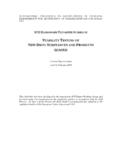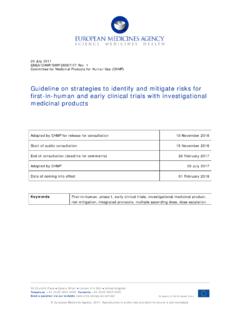Transcription of Guideline on setting health based exposure limits …
1 20 November 2014. EMA/CHMP/ CVMP/ SWP/169430/2012. Committee for Medicinal Products for Human Use (CHMP). Committee for Medicinal Products for Veterinary Use (CVMP). Guideline on setting health based exposure limits for use in risk identification in the manufacture of different medicinal products in shared facilities Draft Agreed by Safety Working Party December 2012. Adoption by CVMP for release for consultation November 2012. Adoption by CHMP for release for consultation 13 December 2012. End of consultation (deadline for comments) 30 June 2013. Adoption by CVMP 11 September 2014. Adopted by Safety Working Party October 2014.
2 Adoption by CHMP 20 November 2014. Date for coming into effect 01 June 2015. Keywords Shared facilities, risk identification, exposure limits , toxicological data, residual active substances, PDE. 30 Churchill Place Canary Wharf London E14 5EU United Kingdom Telephone +44 (0)20 3660 6000 Facsimile +44 (0)20 3660 5555. Send a question via our website An agency of the European Union European Medicines Agency, 2014. Reproduction is authorised provided the source is acknowledged. Guideline on setting health based exposure limits for use in risk identification in the manufacture of different medicinal products in shared facilities Table of contents Executive summary.
3 3. 1. Introduction (background).. 3. 2. Scope .. 3. 3. Legal basis .. 4. 4. Determination of health based exposure limits .. 4. Calculation of a Permitted Daily exposure (PDE) .. 4. Use of clinical data .. 6. Extrapolation to other routes of administration .. 6. 5. Specific considerations .. 7. 6. Reporting of the PDE determination strategy .. 9. 7. Implementation .. 9. 8. Definitions .. 9. References: .. 10. 11. Guideline on setting health based exposure limits for use in risk identification in the manufacture of different medicinal products in shared facilities EMA/CHMP/CVMP/SWP/169430/2012 Page 2/11. Executive summary When different medicinal products are produced in shared facilities, the potential for cross- contamination is a concern.
4 Medicinal products provide a benefit to the intended patient or target animal; however as a cross contaminant, they provide no benefit to the patient or target animal and may even pose a risk. Hence, the presence of such contaminants should be managed according to the risk posed which in turn are related to levels that can be considered safe for all populations. To this end, health based limits through the derivation of a safe threshold value should be employed to identify the risks posed. The derivation of such a threshold value ( permitted daily exposure (PDE). or threshold of toxicological concern (TTC) should be the result of a structured scientific evaluation of all available pharmacological and toxicological data including both non-clinical and clinical data.)
5 Deviation from the main approach highlighted in this Guideline to derive such safe threshold levels could be accepted if adequately justified. 1. Introduction (background). During the manufacture of medicinal products accidental cross-contamination can result from the uncontrolled release of dust, gases, vapours, aerosols, genetic material or organisms from active substances, other starting materials, and other products being processed concurrently, as well as from residues on equipment, and from operators' clothing. Due to the perceived risk, certain classes of medicinal product have previously been required to be manufactured in dedicated or segregated self- contained facilities including, certain antibiotics, certain hormones, certain cytotoxics and certain highly active drugs.
6 Until now no official guidance is available in order to assist manufacturers to differentiate between individual products within these specified classes. Chapters 3 and 5 of the GMP. Guideline have been revised to promote a science and risk- based approach and refer to a toxicological evaluation for establishing threshold values for risk identification. Cleaning is a risk reducing measure and carry-over limits for cleaning validation studies are widely used in the pharmaceutical industry. A variety of approaches are taken in order to establish these limits and often do not take account of the available pharmacological and toxicological data.
7 Hence, a more scientific case by case approach is warranted for risk identification and to support risk reduction measures for all classes of pharmaceutical substances. The objective of this Guideline is to recommend an approach to review and evaluate pharmacological and toxicological data of individual active substances and thus enable determination of threshold levels as referred to in the GMP Guideline . These levels can be used as a risk identification tool and can also be used to justify carry over limits used in cleaning validation. While Active Pharmaceutical Ingredients (APIs) are not discussed in Chapters 3 and 5 of the GMP Guideline , the general principles outlined in this Guideline to derive a threshold value for risk identification could be applied where required.
8 Deviation from the main approach highlighted in this Guideline to derive safe threshold levels could be accepted if adequately justified. 2. Scope The scope of the present Guideline is to ensure the safety of human patients and target animals exposed to residual active substances via medicinal products as well as consumers potentially exposed to residual active substances present in food of animal origin as a result of treatment of food producing animals with veterinary medicinal products in which residual active substances are present. Guideline on setting health based exposure limits for use in risk identification in the manufacture of different medicinal products in shared facilities EMA/CHMP/CVMP/SWP/169430/2012 Page 3/11.
9 In doing so, this document aims to recommend an approach for deriving a scientifically based threshold value for individual active substances to be applied for risk identification. The Guideline outlines how the data on which the threshold value is derived should be presented in order to achieve a clear and harmonious approach across pharmaceutical industry. 3. Legal basis This Guideline should be read in conjunction with: EudraLex - Volume 4 Good manufacturing practice (GMP) guidelines , Chapter 3 and 5. Note for Guidance on Impurities: Residual Solvents (CPMP/ICH/283/95 in conjunction with CPMP/ICH/1507/02, CPMP/ICH/1940/00 corr, CPMP/QWP/450/03, EMEA/CVMP/511/03 and CPMP/QWP/8567/99).
10 VICH GL18(R): Impurities: Residual solvents in new veterinary medicinal products, active substances and excipients (EMA/CVMP/VICH/502 ). Guideline on the limits of Genotoxic Impurities (EMEA/CHMP/QWP/251344/2006 and CPMP/SWP/5199/02). 4. Determination of health based exposure limits Calculation of a Permitted Daily exposure (PDE). The procedure proposed in this document for determination of health based exposure limits for a residual active substance is based on the method for establishing the so-called Permitted Daily exposure (PDE) as described in Appendix 3 of ICH Q3C (R4) Impurities: Guideline for Residual Solvents and Appendix 3 of VICH GL 18 on residual solvents in new veterinary medicinal products, active substances and excipients (Revision).













